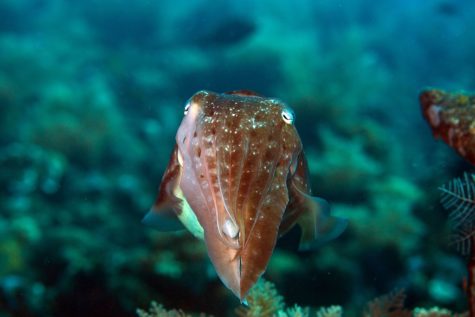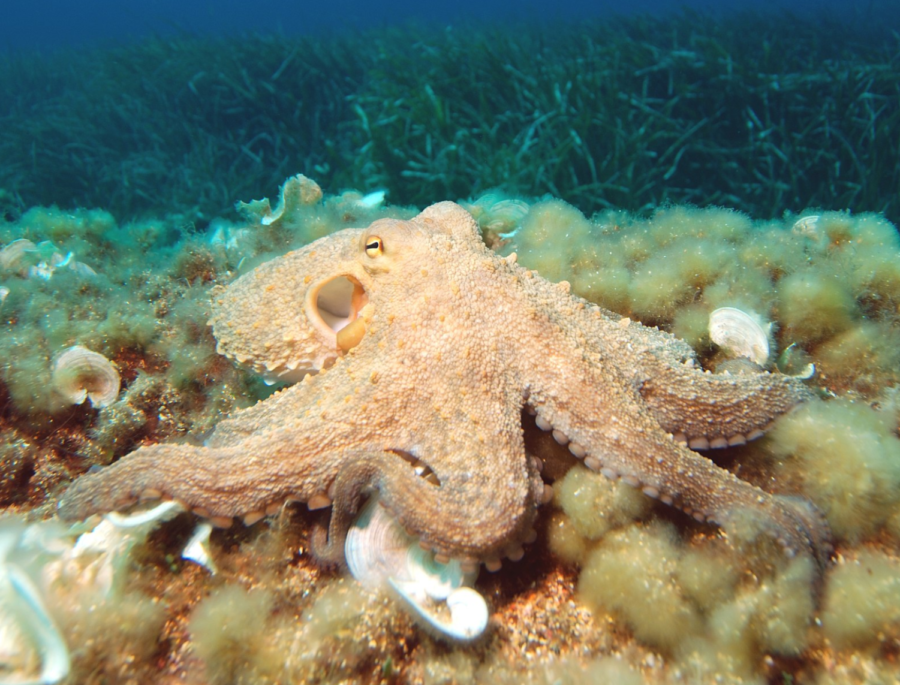Save the Cephalopods: Cephalopod Rights in Animal Testing
As cephalopods become a more frequent subject in animal testing, their lack of protective rights is an increasing safety concern.
albert kok, CC BY-SA 3.0
Researchers are beginning to use Octopi more commonly as subjects in neuroscience research.
Cephalopods are a somewhat unknown class of animals in the mollusc phylum, including octopuses, squids, cuttlefish and nautilus. They are known as “keystone” animals, meaning that their existence plays a large role in the wellbeing of their ecosystem. Their incredible intelligence has made them a newly popular subject in neuroscience research. But despite their growing popularity in the world of animal testing, U.S. animal welfare laws turn a blind eye to them.
Certain regulations must be followed during animal testing. The National Institute of Health (NIH) enforces the humane treatment of all research animals. The Public Health Service Policy on Humane Care and Use of Animals (PHS) and USDA Animal Welfare Regulations (AWR) are the primary federal regulations enacted by the government. Protocols include proper housing for the animals, appropriate use of anesthesia, minimization of post operative distress, and more. These policies enforce that institutions must use proper care when working with animals. Regulations vary depending on species, and whether the institution’s funding is federal or private. However, these incredibly important guidelines that apply to “all animals” in truth only protect vertebrates (animals with backbones). Invertebrates (animals without backbones), such as cephalopods, are left completely defenseless by rules (both in federally and privately funded research projects) intended to keep animals safe from abuse.
To get a better perspective of what testing with animals covered by welfare laws in the U.S. is like, I reached out to Alison Weiss. Alison Weiss is a Research Assistant Professor at Oregon Health & Science University, and the Oregon National Primate Research Center. She works with monkeys (which are covered by U.S. welfare laws) in neuroscience research. Her research focuses on cognitive changes associated with aging and neurocognative diseases. She uses non-invasive methods in her research such as MRI scans and having the monkeys play computer games. Her facility follows all the animal testing regulations mentioned previously.
“I strongly believe that these regulations are critical for the protection of our precious research animals, and the staff that work with and care for them. Research animals make incredibly valuable contributions to both human and animal health and well-being, and it is our duty to care for them with the highest standards possible. I personally would not work at any facility that does not meet these standards,” said Weiss.
Weiss emphasizes the impact of these regulations of the health and wellbeing of not just animals, but also researchers. Protocol requires research facilities to have a safe working environment for personnel. They ensure that the relationship between researcher and test subject is a positive one. Cephalopods are unprotected by these policies, which as Weiss stated, are critical for their protection.
So why are these intelligent creatures not included in animal welfare laws? Much of it stems from the belief that they do not feel pain or experience emotions. The scientific consensus is that all vertebrate animals experience pain, but for invertebrate animals however, the consensus is that their brains are not complex enough to feel pain. Although this may be true for many invertebrates, cephalopods are an outlier among the community.
Cephalopods are smart. They are considered sentient beings (capable of perceiving or feeling things) by the Animal Welfare Bill. This is a quality that separates them from the majority of invertebrates. They have large brains, complex behaviors, and possess cognitive abilities on par with many vertebrates. Octopi for example, are some of the smartest animals on Earth. They have the most complex brains of all the invertebrates. Just like lab rats, they have been proven to have sophisticated navigation skills, finding their way through mazes and puzzles. In other fields they have actually been proven to be more intelligent than lab rats.

(Prilfish from Vienna, Austria, CC BY 2.0, via Wikimedia Commons)
Cuttlefish (another member of the cephalopod class) have demonstrated intelligence similar to that of human children. A famous experiment called the “Marshmallow Test” was created in 1972 at Stanford University with the goal of testing children’s abilities to delay gratification and resist giving into impulse. In the experiment, one marshmallow was placed in front of a child. The child would be told that they could have that one marshmallow then, or wait and get a second one. Cuttlefish will hunt less crab during the day as at night, shrimp (their preferred food) come out. Just as a child restrains themself from taking the first marshmallow and waits for a second, a cuttlefish restrains itself from the hunting crab and waits for the shrimp.
But beyond tests that have proven cephalopods’ intelligence, other experiments directly indicate that cephalopods experience pain
Pain is measured in two components: The sensory (intensity), and the affective (unpleasantness). A study done at San Francisco State University in 2021 tested octopuses’ ability to experience the affective. In the study, octopi were placed into a three chambered box. In one chamber, they received a painful injection of acetic acid. In another chamber, they received an injection of pain reliever. The study found that the octopi avoided the chamber where they received the acid, and preferred to go to the chamber where they received pain relief. This concluded that octopi are in fact likely to experience the affective component of pain. What was interesting about this experiment was that it was originally designed to study rats’ responses to pain. The octopi reacted the same way as the rats, who are accepted to feel pain and are included in welfare laws.
Although efforts are being made to prove that cephalopods feel pain, there is no one-hundred percent conclusive answer to this debate. In the interest of sympathy, we should be operating on the theory that they do. Leaving this large group of animals unprotected because of the idea that they don’t feel anything is incredibly dangerous. Some of the research done with them is invasive and painful, using methods such as food deprivation, and electrical shocking. These animals cannot speak up and tell us, “stop” for themselves; it is the duty of humans to do so.
Animal rights activists all over the world have been fighting for the rights of cephalopods. The Animal Law & Policy Clinic at Harvard University are advocating for the NIH to adjust their laws to include cephalopods. Their petition can be found here.
The European Union, United Kingdom, Australia, Canada, Switzerland, and Norway have all taken the step to protect cephalopods, and included them in their animal welfare laws. The United States has fallen behind and needs to catch up to the standards held for animals in other countries.
These animals cannot speak up and tell us, “stop” for themselves; it is the duty of humans to do so.
Eilidh Ince is a Copy Chief and Social Media Manager for 'The Science Survey.' Eilidh enjoys using journalism as a platform to express her passions, interests,...

